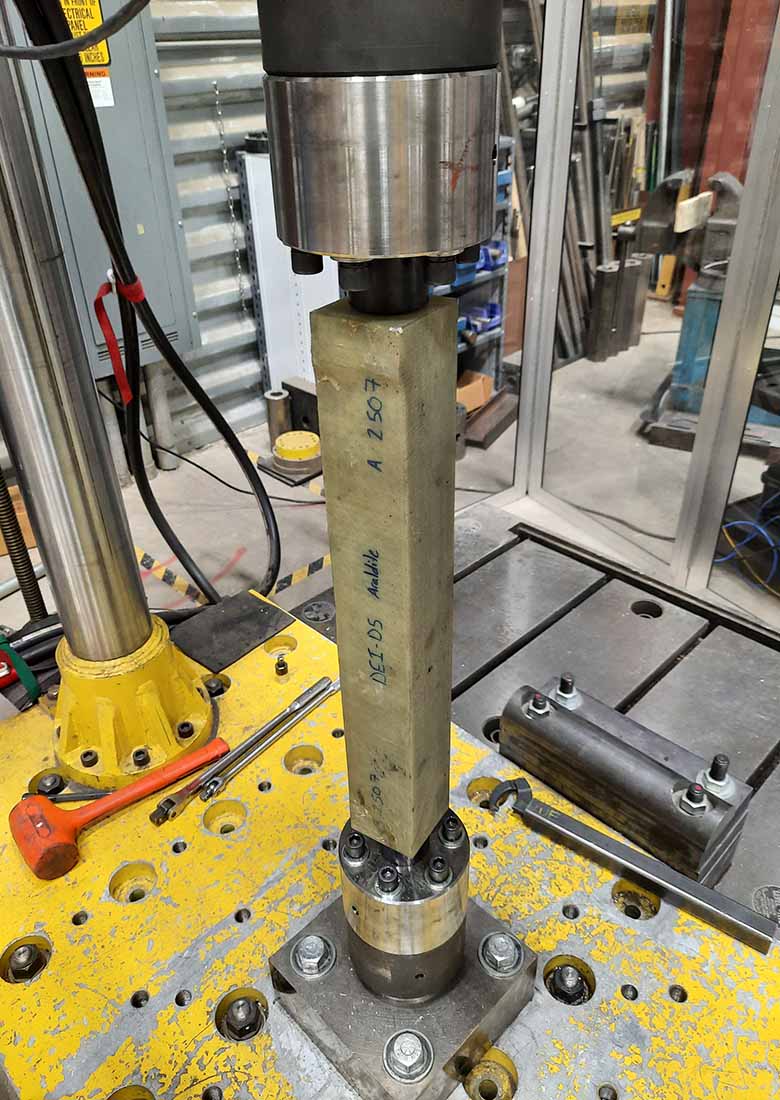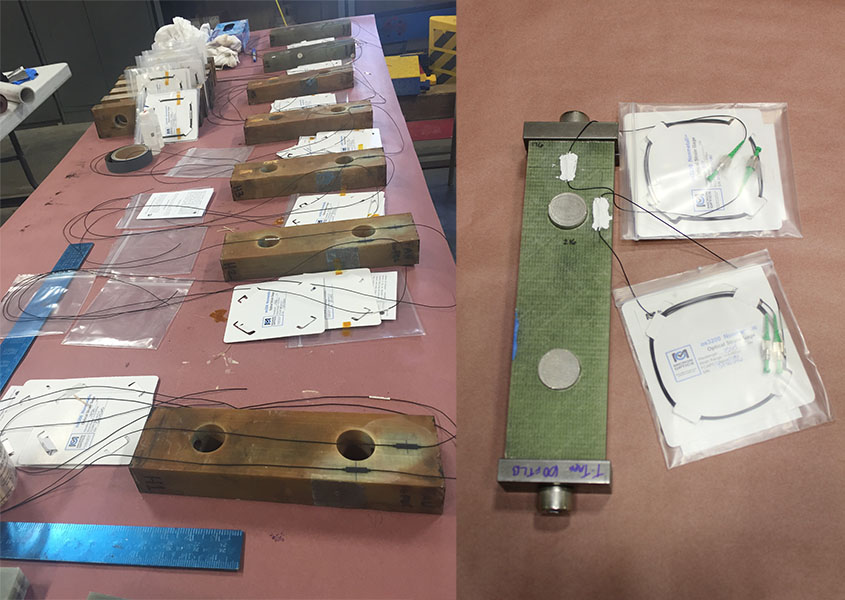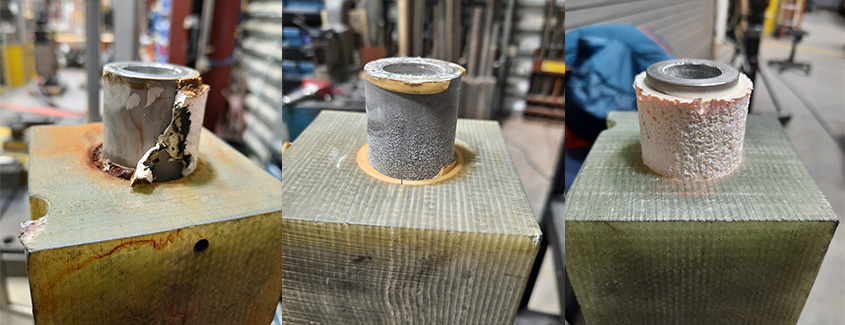New Study Breaks Materials Down—Literally
In Largest Study of Its Kind, Researchers Rapidly Age Over 300 Material Specimens To Learn Which Could Survive Longest in Underwater Marine Energy Technologies
Strange things are happening in salt water.
Today, a budding fleet of renewable marine energy technologies are leaving labs to go through their first river and ocean tests. But as they take these big steps toward commercial use, many are encountering an unpredictable and inhospitable environment: salt water.
Salt water, as marine energy researchers are learning, can perform some chemistry on certain types of materials, causing them to corrode, interact, or degrade in unpredictable ways.

“One of the reasons we’re doing this work is so companies don’t have to invest lots of time and money to find out the hard way,” said Paul Murdy, a mechanical engineer at the National Renewable Energy Laboratory (NREL).
Here is the hard way: Technology developers sink a whole lot of effort and cash into designing a prototype only to discover that, once it is out at sea, their chosen materials might not survive for long.
Now, the results from a new study in which researchers tested how well different materials endured both salt water and stress tests could help companies find an easier route to the ocean.
The multiyear study, which is the largest of its kind, recently culminated in a report titled "Subcomponent Validation of Composite Joints for the Marine Energy Advanced Materials Project." The study collected much-needed data on the benefits and pitfalls of about 300 different specimens built from materials commonly used in marine energy devices. These include steel and fiberglass composites (which are constructed with glass fibers combined with plastics that can harden permanently) and the adhesives that bind them together.
In the report, which summarizes the study’s methods and findings, the authors explain which materials degraded more quickly than expected, why some strange phenomena will need further study, and how this effort could help improve future materials testing.
“At this point, the industry just needs guidance,” said Murdy, one of the authors on the report.
To provide that guidance, the U.S. Department of Energy’s Water Power Technologies Office formed a multi-institutional team led by Sandia National Laboratories with collaborators from Florida Atlantic University, Montana State University, NREL, and Pacific Northwest National Laboratory.
From 2019 to 2022, the team manufactured a variety of brick-sized specimens as well as bigger subcomponents of common shapes. That way, the study’s findings could be applied to components used in almost any marine energy device. At NREL, Murdy and his colleagues manufactured 300 specimens in six different geometries (such as T-shaped bolted connections) to represent the various combinations of the marine energy industry’s most-used materials, including fiberglass, steel, and adhesives.

To test how well these materials might survive for up to 20 years in a salty, wet environment, researchers at Florida State University and Pacific Northwest National Laboratory subjected the components to ocean-water baths. Researchers at Pacific Northwest National Laboratory designed some baths to encourage natural microbial growth. But Florida State’s ocean bath was especially torturous, using hotter temperature water, heated to about 136 degrees Fahrenheit. Heat can rapidly age materials, just like obsessive sunbathing can rapidly age skin.
Finally, after soaking the materials for up to 18 months, the team shipped the components back to NREL’s Structural Technology Laboratory for stress tests. For some of these tests, a machine slowly tugged on the material until it broke; in others, a different machine pulled and released the material, sometimes more than a million times, until it gave out. “We’re trying to apply a lifetime’s worth of loading in a few days to weeks,” Murdy said.
Through all these tests (or torments), the team amassed data on how long certain materials lasted, whether some degraded or corroded faster in the salt water, and which absorbed more water—another indication the device might not last as long in the ocean. And although more information is always a good thing, some of the team’s findings might not make it easier for a developer to pick the best material.
“Some were very good in some circumstances but very, very bad in others,” Murdy said. “And each material had its own merit, which would make it particularly difficult to choose.”
Some specimens, including those with steel embedded deep within a composite, held up well. But others, like those that paired a specific fiberglass composite with certain steel, exhibited significant corrosion. Some parts failed altogether or were too corroded to function. And materials subjected to the high-temperature bath absorbed more water, which was not surprising, although even partial saturation affected the materials’ strength and endurance.

But the biggest surprise was that some samples had different—and unusual—reactions to Pacific Ocean water versus Atlantic Ocean water, corroding at a shockingly fast rate in West Coast waters. “We think it has to do with the saltwater chemistry,” Murdy said. Or, it might have to do with oxygen; the Pacific Ocean water had higher oxygen concentrations than the Atlantic Ocean water. But the researchers are not sure what exactly is going on.
Next, the multi-institutional group plans to further investigate this strange saltwater chemistry with even more saltwater tests. The laboratory will also experiment with other materials, like recyclable plastic resins, and assess which might be best suited for 3D printing, which could help the marine energy industry manufacture prototypes faster and at a lower overall cost.
But, in addition to learning how different materials react to salt and stress, the team has another goal in mind. Through this 3-year process, the laboratories learned that testing materials may be incredibly valuable for the marine energy industry, but it is also time-consuming and expensive. Now, based on this first, large-scale effort, they hope to perfect the process to make future materials testing a little less cumbersome and more accurate.
Because marine energy devices must handle vigorous waves while steeping in salt water, combining the saltwater baths with endurance testing could be a more accurate way to see how materials might survive ocean missions.
“Composite materials have been used a lot in aerospace and the wind energy industry,” Murdy said. “But the big challenge is accounting for the marine environment, which is far less understood. The more understanding you have, the more cost you can save in the long run.”
Want more material insights? See what over 100 marine energy experts discussed in a recent U.S. Department of Energy workshop on materials and manufacturing. Learn more about NREL’s work to advance marine energy. And subscribe to the NREL water power newsletter, The Current, to make sure you do not miss a water power update.
Last Updated May 28, 2025
